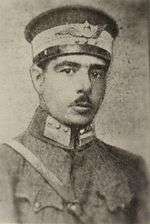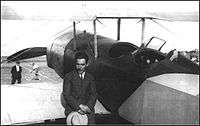Vecihi Hürkuş
| Vecihi Hürkuş | |
|---|---|
 | |
| Born |
6 January 1896 Istanbul, Turkey |
| Died |
16 July 1969 Ankara, Turkey |
| Occupation | Aviator, Engineer, Entrepreneur |
Vecihi Hürkuş (6 January 1896 – 16 July 1969) was pilot fought at World War I and Turkish Independence War, aviation engineer and aviation pioneer in Turkey. He designed and built the first airplane in Turkey. He founded first Airline company in Turkey.
Born in Istanbul, he fought during World War I. When he returned to Yeşilköy he was injured. Subsequently, he joined Tayyare Mektebi, the Ottoman aviation school. Soon after receiving his pilot certificate he commenced bombing and reconnaissance missions against the Russians. In one of these sorties he shot down a Russian airplane, becoming the first Turkish pilot to bring down an enemy aircraft.
He was subsequently taken prisoner by the Russians but managed to escape from Nargin island to Iran by swimming. Following his escape, he returned to Istanbul and joined the 9th combat aircraft squadron in 1918. He designed a fighter airplane but could not finish the project due to the terms contained within the Montreux Ceasefire Agreement. During the Turkish War of Independence he shot down a Greek airplane,[1] and made the first and last flights of the war.
After the war and despite many obstacles, he designed and built his first airplane and a few other aircraft inside a converted saw mill which he had rented for that purpose. He used aircraft engines he had acquired during World War I to power the planes he manufactured.
He adopted the surname Hürkuş ("Freebird") after the Surname Law of 1934, and founded Hürkuş Havayollari (Freebird Airlines) in 1954.
Firsts
Vecihi Hürkuş is Turkey's most celebrated aviator. He was the first Turk to:

- shoot down an enemy aircraft on the Caucasus front during World War I,
- fly a twin-engine aircraft (1917 - Caucasian Front - captured Russian Caudron G.4),
- manufacture a propeller from scratch (1918 - Istanbul - Nieuport 17 captured from the Russians),
- produce adhesive from gelatin to glue fabric to aircraft wings (Turkish War of Independence),
- first to land at İzmir Seydiköy Airfield during the Turkish War of Independence, occupying it single-handedly. This was considered to be the final flight of the war,
- fly a passenger aircraft (1923 - Edirne - 9 passengers with an abandoned Italian Caproni Ca.5 aka Ca.57 or Breda M-1),
- construct a military aircraft from scratch (1924 - Izmir - Vecihi K-VI, first flight - January 28, 1925),
- build a speedboat (1930 - Kadıköy, Istanbul - Vecihi-SK-X),
- build a civilian aircraft (1930 - Kadıköy - Vecihi K-XIV)
- establish a civilian flying school (April 21, 1932 - V.S.T.M. Vecihi Sivil Tayyare Mektebi - Kadıköy),
- construct a seaplane (1933 - Kadıköy, Vecihi S-XVI),
- train the first female Turkish aviator (1933 - Bedriye Bacı (Gökmen) Kadıköy, Istanbul)
- construct the country's first gliders (US–4 ve PS–2), while playing a pivotal role in the establishment of Turkish Bird (1935-1936 - Etimesgut - Ankara),
- receive a diploma abroad in aircraft engineering (February 27, 1939 - Weimar Engineering School, Germany),
- establish a privately funded aviation publication (1948 - Kanatlılar Dergisi)
- establish a private airline company in Turkey (November 29, 1954 – 1960 Yeşilköy - Hürkuş Havayolları transported passengers and cargo),
- conduct aerial surveys for the Mining Research Institute (1961–1966).
During his flying career, which spanned a period of 52 years (1916–1967), Vecihi Hürkuş flew a total of 102 different models of aircraft and spent 30,000 hours, that is, 3.4 years of his life in the cockpit.
In 1994, he was honored posthumously with the International Civil Aviation Organization's (ICAO) 50th Anniversary Award (1944–1994) for the considerable contributions he made to the field of civil aviation in Turkey.
Family
During the War of Independence, Vecihi married Hadiye, the daughter of the chief of police in Akşehir. They had two daughters, Gönül (Hürkuş Şarman) and Sevim (Hürkus Maxson). In 1925, he divorced Hadiye and married his childhood sweetheart İhsan. Another daughter, Perran (Ülgen-Hürkuş), was born in 1927.
Legacy
The TAI Hürkuş turboprop trainer to be built by Turkish Aerospace Industries is named after Vecihi Hürkuş.[2][3]
See also
Sources
- Vecihi Hürkuş, Havalarda, 1915-1925, İstanbul, Kanaat Kitabevi, 1942.
- Vecihi Hürkuş, Bir Tayyarecinin Anıları: Yaşantı, İstanbul, YKY, 2000 ISBN 978-975-08-0219-5
- Mehmet Gürbüz Gürer, Vecihi Hürkuş "Göklerin Korkusuz Adamı", İstanbul, 2001.
- M. Bahattin Adigüzel, Türk Havaciliğinda İz Birakanlar, Ankara, 2001.
References
External links
- Biography
- War of Independence-Military Action in 1920 (Turkish)
- Hürkuş
- Turkish Aerospace Industries-TAI
- Photos about Vecihi Hürkuş
| Wikimedia Commons has media related to Vecihi Hürkuş. |